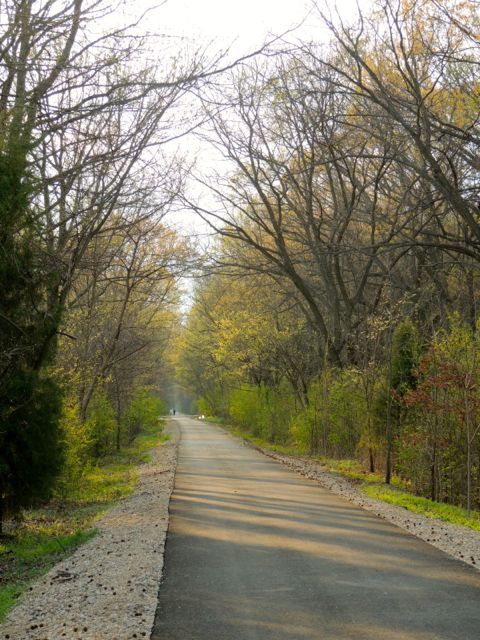Letting Nature In
/Over the past year, I found myself opposing a mixed use development near my neighborhood -- a rather awkward position for an avowed conservationist to find herself in. Awkward because mixed use development and infill development are two important ways that urban planners can lessen the footprint of cityscapes on the land, making it easier to leave more open space for agriculture, forests, and habitat.
Although many of us supported the infill aspect of the development, our reasons for opposing the mixed use were many. They included three (now four) midrise apartment towers (originally proposed as 9-stories and later amended to 6) plopped down in the middle of a typical single-family home suburban residential neighborhood. Traffic at the time, exacerbated by nearby work on Interstate 40, was already a headache and seemed destined to become a permanent nightmare with the potential of up to 2,600 more cars in a relatively small space.
But above all, my own personal reasons for opposing were aesthetic. This development, called “Parkside,” borders the 4,400-acre Shelby Farms Park — America’s largest urban park located in Memphis, TN — as well as its Greenline trail.
Please don’t mix your city with my park
Although aesthetics is the most impractical of arguments against development, it’s notable that a majority of comments from people, left on the opposition Facebook page and on the community’s >1,300-signature petition opposing Parkside, focused on loss of beauty and an anticipated decline in the quality of the park experience. People expressed sadness and anger at the prospect of heavy traffic, tons of people, businesses, and tall buildings looming over this bucolic park.
Shelby Farms Park is extraordinary because it allows roughly 1 million residents of our greater metro region to access, right within city limits, areas without any visual traces of the city: no pavement, no concrete, no cars, no buildings. It may not be possible to entirely escape the muted sound of distant traffic, but it is deeply calming simply to be surrounded by living plants, pond views, birdsong and nothing else.
Inviting Nature in
We lost our battle last year, and Parkside will be built. Ironically, I now find myself hoping that the developer is successful because for good or ill, the fate of my neighborhood is now tied up with that of Parkside. I also hope that as details of Parkside’s design and landscaping take shape, he will consider inviting nature into the development as a counterbalance to the cityscape he is bringing into the Park. In so doing, he would be joining a distinguished and visionary group of thinkers who are calling for a new way of approaching habitat, wildlife, and green spaces within cities.
One such thinker is Doug Tallamy, author of Bringing Nature Home. He promotes this simple approach: instead of thinking where we might “leave” areas for landscaping, we should think what is the minimum we need to take and let the rest remain. In a 2015 interview with High Country Gardens, he said, “Abandon the age-old concept that humans live here and nature is somewhere else and embrace the concept that we need to share our spaces with nature. We enjoy a walk in the woods; we enjoy seeing butterflies, birds, beautiful flowers, etc. Research has shown that spending time in nature is the very best way to recharge your attention span and deal with the stresses of life. Living with nature is a healthy necessity, not a sacrifice we must endure.” This is something that Parkside developers are betting on!
Tallamy continues: “We have 45.6 million acres of lawns and it is growing by 500 square miles each year. That’s an area 8 times the size of New Jersey from which the species that run our ecosystems have been removed. . . . Lawn should be restricted to the areas on which we walk in our landscapes; it is a mechanism for guiding us through our landscapes. Lawn should not be our default landscaping practice.”
Making the Greenline less green
Current plans for the roads to accommodate Parkside traffic will require removal of some trees along the shaded Greenline Trail that marks the northern park boundary and Parkside’s southern edge. In addition, the developer has proposed taking on management of the trail fronting his property by clearing the “underbrush” from beneath the Greenline’s oaks and maples and installing a lawn.
This may sound like a small thing, but this is how it begins: we let the urban creep into our natural areas bit by bit until they are unrecognizable as natural.
Bicyclists, joggers, walkers, and wildlife watchers who venture along such a sanitized portion of the Greenline will be unlikely to see cardinals flit across the trail, to hear the scolding calls of wrens that nest in the trailside shrubs, or the song of the towhee that skulks in the underbrush. They will not see Black-eyed susans blooming at the trail’s edge, and without flowers and blooming shrubs there are sure to be no bees or butterflies either. Trail users will no longer feel cool when the sun sits low in the sky and the sun’s rays heat the paved trail formerly enclosed by vegetation. All of this in exchange for what? A clipped lawn that costs money to maintain, including regular (and noisy) mowing during spring and summer.
Having lost the battle to prevent an urban invasion of my natural area park, I would like to ask the Parkside developer to consider inviting more nature into his mixed use design. As the dominant species on the planet, we have to do better at inviting nature into our yards, our parks, and our businesses while preventing “city creep” into the forests, meadows, and streamsides we still have left.



